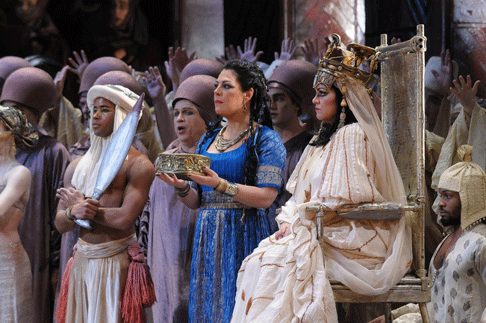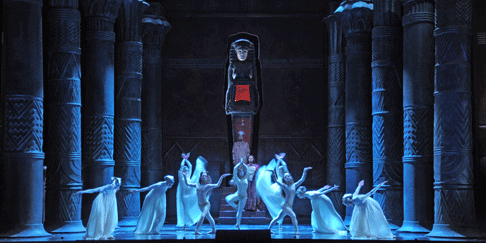17 Feb 2012
Verdi’s Aida at Lyric Opera, Chicago
In its current revival of Giuseppe Verdi’s Aida Lyric Opera of Chicago approaches the challenges of the ambitious score with a cast well suited to the music and to the drama.

In its current revival of Giuseppe Verdi’s Aida Lyric Opera of Chicago approaches the challenges of the ambitious score with a cast well suited to the music and to the drama.
Under the direction of conductor Renato Palumbo the Ethiopian slave Aida is sung by Sondra Radvanovsky, Amneris by Jill Grove, Radames by Marcello Giordani, Ramfis by Raymond Aceto, Amonasro by Gordon Hawkins, and the King by Evan Boyer. At the start of the overture Palumbo emphasized soft, legato playing among the strings with the cellos standing out in gradual contrast. In the middle segment of the overture familiar melodies associated later with specific characters and scenes were etched out with clarity and crisp playing. A return to piano delicacy rounded out the overture fittingly under Palumbo’s direction.
In Act One soon after the announcement by the priest Ramfis that direction will be given to the Egyptian army the first scene of divided loyalties features the officer Radames. Torn between his military ambitions and his love for the slave Aida, Radames gives vent to his emotions in the celebrated aria, “Celeste Aida.” Mr. Giordani sings here with an open, clarion approach, the top notes taken forte and with full confidence. In contrast, his final thoughts of the beloved are sung with an effective diminuendo. Mr. Giordani’s conception of the role and the complexities of character deepen as he proceeds into the following acts, so that softer modulations evident later appropriately enhance the initial impression given here. At the subsequent appearance of Amneris, daughter of the Egyptian king, Ms. Grove struck a challenging figure by infusing an Italianate sense of line with extremely effective low pitches. Her duet with Radames was occasionally overshadowed by the orchestra, yet Ms. Grove’s thrilling and secure top notes left her emotional ambitions for Radames clearly dominant.
At the entrance of Aida the musical scene develops into a trio in which Ms. Radvanovsky’s skillful piano singing suggested gradually oppositional relationships. Such a conflict is intensified in the following two scenes, first in the presence of the King and second in the temple of Vulcan. When the King, sung with well-controlled declamation by Mr. Boyer, announces Radames as the chosen leader to thwart the Ethiopian invasion, the soloists and chorus declare their enthusiasm. In response to the choral cries of “Ritorna vincitor!,” Aida sings her celebrated aria of the same line with intersecting thoughts on homeland and love. Here Radvanovsky’s middle range was especially well deployed with touching diminuendo and a beautifully produced final note on “soffrir.” In the final scene of this act located in the temple politics and religion focus again on the forthcoming battles and prayers for the victory of Radames and his troops. The choral exposition was here appropriately emphatic. As Ramfis the high priest invested Radames with the ceremonial sword, both Aceto and Giordani expressed their devotion with a noteworthy sense of legato.
 Sondra Radvanovsky as Aida and Jill Grove as Amneris
Sondra Radvanovsky as Aida and Jill Grove as Amneris
In the first scene of Act Two Amneris discovers indeed the secret of Aida’s love for Radames. In their duet Grove and Radvanovsky were dramatically convincing in their exciting duet “Fu la sorte.” Grove’s powerful notes on “Trema!” after confirming the truth expressed her determination to exact revenge. In response, Radvanovsky’s touching pleas on “Numi, pieta” drifted into the air but remained unheeded. As the outcome of the battles dominates the start of the next scene, Ethiopian prisoners are brought in after a parade led by the victorious Radames. A ballet conducted in honor of the King was especially well performed. The vocal ensemble with, on one side, Aida and her father Amonasro as an Ethiopian prisoner, on the other, Amneris, the King, and Radames was well staged and seamlessly conducted. The act ended with Grove’s triumphant declarations in response to the King giving her hand in marriage to Radames.
The single scene of Act Three of Aida on the banks of the Nile has often been emphasized for its dramatic and vocal significance. In this production the realistic atmosphere in the scene was introduced by a boat seeming to glide along the river. After Ramfis utters a prayer for Amneris and her marriage in the temple, Aida sings her romanza, “O patria mia,” surely a highlight of these performances. Radvanovsky assumes a bel canto line in her approach to the aria with exquisite high notes taken on “mai piu” and at its conclusion. In the following duet with her father Amonasro (“Ciel, mio padre”) both Radvanovsky and Hawkins show strong emotional commitment communicated through vocal line and use of rubato. During her impassioned exchange with Radames, Aida finally convinces her lover to flee (“Fuggiam”). The floating piano notes at the end of the duet belie the violent ending of the act when Radames is taken prisoner after the accusation of Amneris.
 Scene from Aida
Scene from Aida
The final act of Aida places Radames in both scenes with the two women vying for his affections strategically divided. At first Amneris attempts to regain control by convincing Radames that she agrees to his defense before the judges. Grove’s transition from hushed notes to a dramatic top gives the impression of unhinged emotions. This heightened tension is enhanced during her duet with Radames. Once he refuses the intervention of Amneris, he also abandons himself to the tribunal. In response to his sentence of death Grove hurls a final dramatic curse at the judges with blood-chilling fury. In the final scene of Act Four Aida joins her beloved in the tomb to die at his side. Radvanovsky and Giordani sang their final duet, “O terra, addio,” with a renewed freshness as though their love formed a bridge to another world. As they sang their final notes in piano unison, Grove’s chants of “Pace” put a seal on their earthly life.
Salvatore Calomino